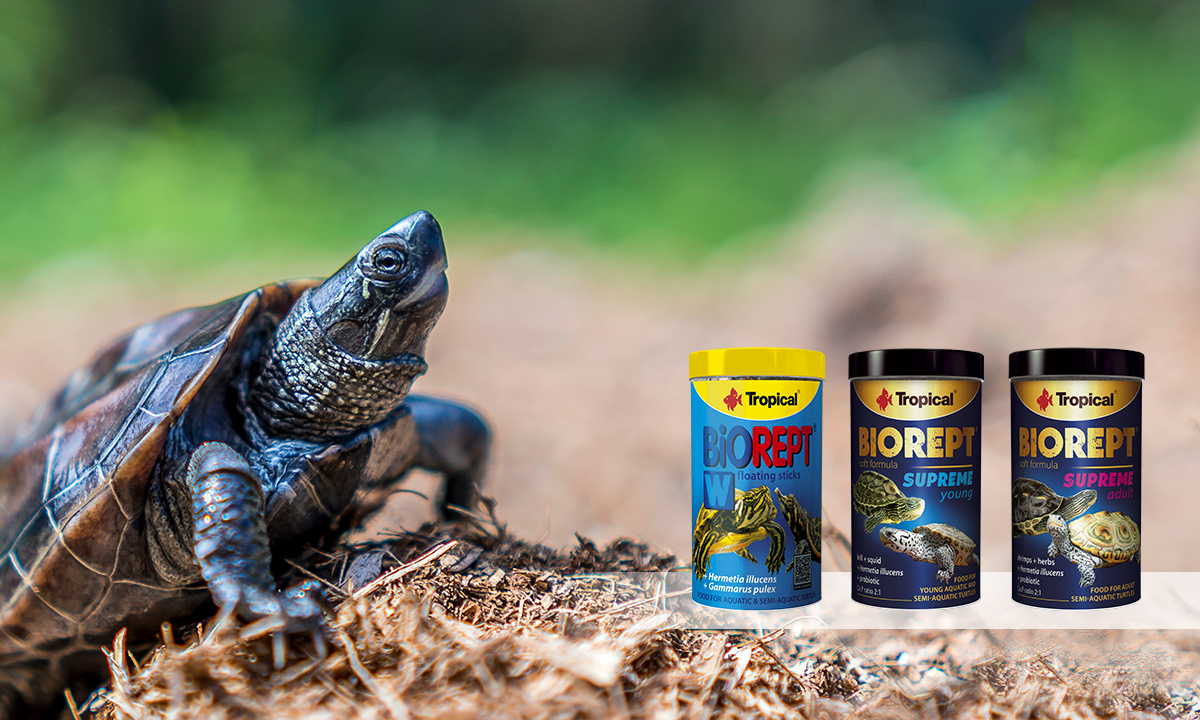What to feed semi-aquatic turtles with?
With each year we have access to more data concerning physiology and nutritional requirements of semi-aquatic turtles, which makes their feeding easier. Perfectly balanced ready-made foods are also helpful. Let me tell you what to feed semi-aquatic turtles to provide a complete diet and ensure their excellent health.
What does digestive tract of semi-aquatic turtles consist of?
It starts with a thin keratinized layer of epidermis known as the rhamphotheca, which replaces teeth. The turtles use it together with their claws to separate bites of food. Their esophagus and stomach are distensible. In the wild, turtles rarely have the opportunity to fully fill their stomachs. Therefore, they have a visible tendency to overeat which means they will eat as much as you offer them.
Protein is digested mainly in their stomachs. The stomach connects with a small intestine, which is involved in the enzymatic digestion of carbohydrates and fats with the help of pancreatic juices and bile secreted in the liver. It is also the place where nutrients are absorbed. In the large intestine, water resorption and microbial fermentation of structural carbohydrates (fiber) takes place. Symbiotic bacteria break down the cell walls of plant matter there. The result is the formation of short-chain fatty acids, which are absorbed by the animal and used as an energy source. The digestive tract of turtles ends in the cloaca, which is the common outlet of the digestive, excretory and reproductive systems.
What do semi-aquatic turtles eat in the wild?
Semi-aquatic turtles are an extensive group of animals with more than 200 species. Most of them are to a large extent omnivorous. However, young, fast-growing individuals (in the first six months of their lives they can double their body weight every month) eat mostly aquatic invertebrates, small fish, amphibian eggs and larvae. As the turtles increase in size, the growth rate decreases, and aquatic and wetland plants begin to dominate the diet. Read more about ontogenetic dietary change in turtles.
Foods for semi-aquatic turtles
Balancing a proper diet for aquatic turtles on one’s own, under home conditions, is difficult. So how to feed semi-aquatic turtles? To meet the needs of pets and their owners, Tropical has prepared an expanded range of foods developed specifically for this group of reptiles. Using complete ready-made foods you can easily meet the needs of turtles of virtually any age.
Biorept W, basic food, which has been present on the market for many years , is now accompanied by soft granules. Biorept Supreme Young with small granule size has been developed for young semi-aquatic turtles. While Biorept Supreme Adult is intended for mature animals, as it is characterized by a reduced share of protein and fat. Importantly, each of the foods contains calcium and phosphorus in a 2:1 ratio. This perfectly corresponds to the nutritional needs of reptiles. Moreover, in order to diversify protein sources in turtles’ diet, it is worth enriching it with Reptiles Carnivore, in case of species with a high demand for plant components – with Reptiles Herbivore.
Natural diet versus ready-made foods for semi-aquatic turtles
The high quality of Tropical foods for semi-aquatic turtles has been confirmed by scientific research conducted at the University of Life Sciences in Poznan. The facility has conducted a detailed analysis of Biorept W and Biorept Supreme Young.
They compared the growth and development of young turtles fed with these products and turtles fed with a 12-ingredient natural diet. The latter included seafood (shrimp, squid, mussels), offal (poultry livers and hearts), salmon (whole, shredded fish), insect larvae (kingworm and Hermetia illucens) and Gammarus.
The tests showed no significant differences in growth and development rates between turtles fed a natural diet and ready-made foods (Biorept W and Biorept Supreme Young). This proves that each Tropical food covers all nutritional needs of young, growing semi-aquatic turtles. In addition, there were no differences in water quality between the two groups of turtles. In addition, it is worth noting that animals fed with Tropical foods showed more intense skin and carapace coloration.
How much should a semi-aquatic turtle eat?
When using complete ready-made foods with a low water content, you give the volume that does not exceed the size of the turtle’s head. For larger animals, it is also worth using the weight criterion which tells not to exceed a dose of 1% of body weight per one meal. When the turtle finishes its meal (after 5 to 10 minutes) all the leftovers should be removed immediately. The amount of food consumed depends on the temperature, and most turtles stop feeding below 16oC.
Should we use any supplements when feeding turtles ready-made foods?
When you use complete foods, such as Tropical ready-made foods, there is no need to use any supplements. These foods are properly balanced in terms of nutritional value, including vitamins and minerals. However, when you provide your turtles with natural diet, you should supplement it with mineral and vitamin products such as Vigorept Multivit or Vigorept Mineral. They can be added to foods and then made into a cake or jelly by using gelatin (known as shrimp mix). Remember that the ratio of calcium to phosphorus in the diet should be at least 2:1. Abundant protein and fat causes excessively fast growth, obesity, and the formation of stones in the bladder and kidneys while calcium and Vitamin D3 deficiency may result in metabolic bone disease (MBD).










